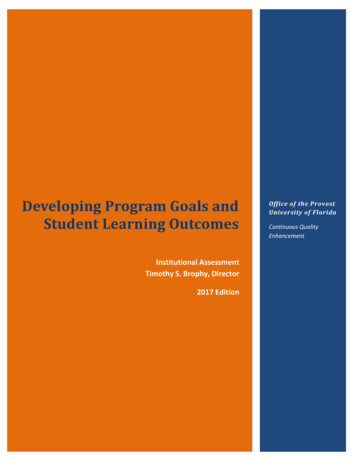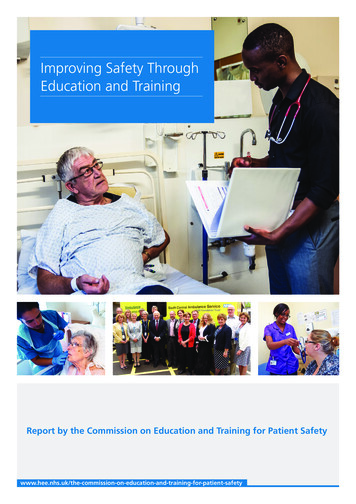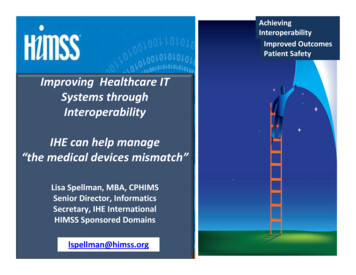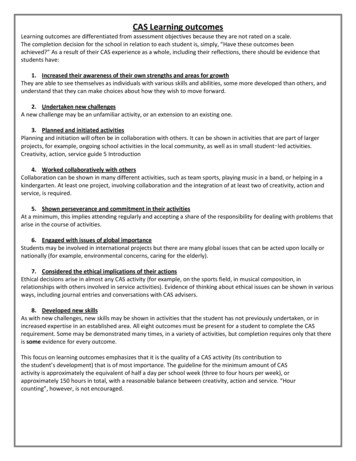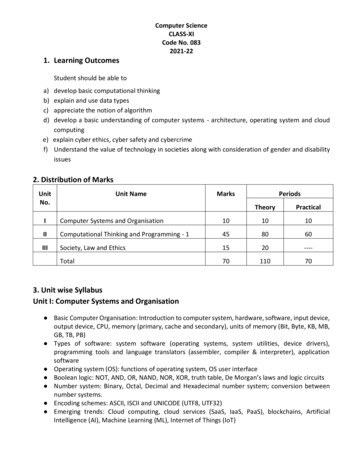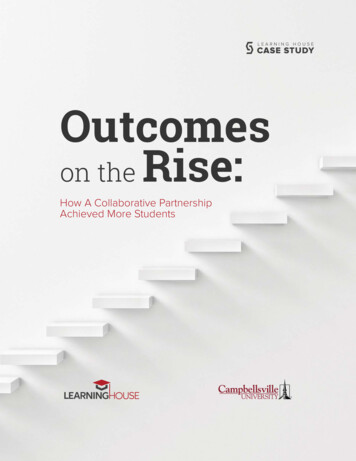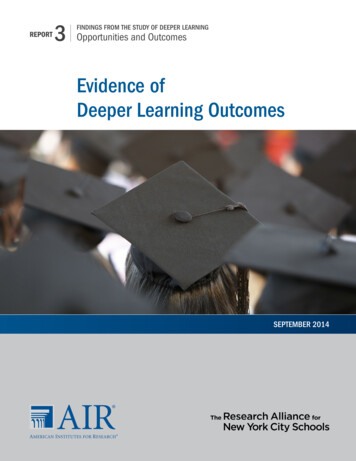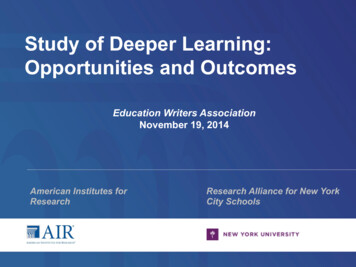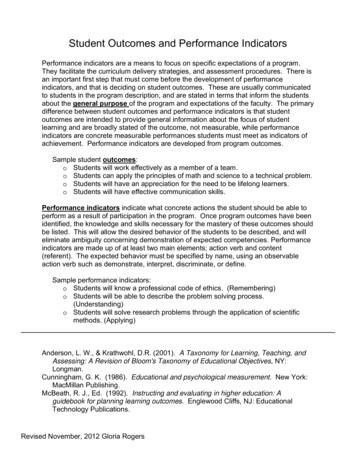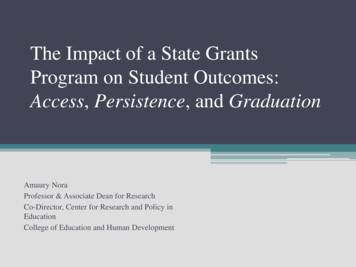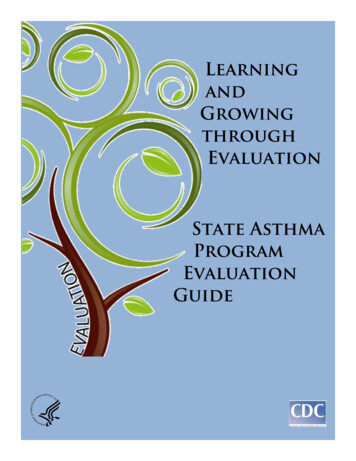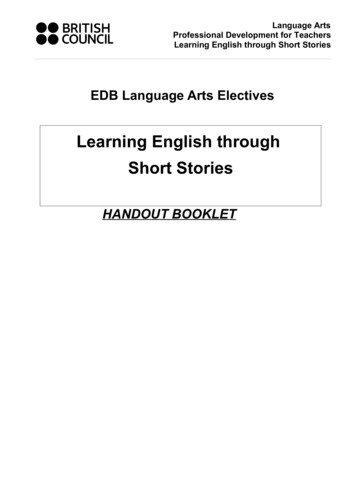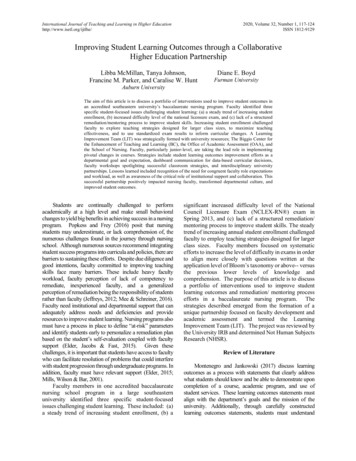
Transcription
International Journal of Teaching and Learning in Higher Educationhttp://www.isetl.org/ijtlhe/2020, Volume 32, Number 1, 117-124ISSN 1812-9129Improving Student Learning Outcomes through a CollaborativeHigher Education PartnershipLibba McMillan, Tanya Johnson,Francine M. Parker, and Caralise W. HuntDiane E. BoydFurman UniversityAuburn UniversityThe aim of this article is to discuss a portfolio of interventions used to improve student outcomes inan accredited southeastern university’s baccalaureate nursing program. Faculty identified threespecific student-focused issues challenging student learning: (a) a steady trend of increasing studentenrollment, (b) increased difficulty level of the national licensure exam, and (c) lack of a structuredremediation/mentoring process to improve student skills. Increasing student enrollment challengedfaculty to explore teaching strategies designed for larger class sizes, to maximize teachingeffectiveness, and to use standardized exam results to inform curricular changes. A LearningImprovement Team (LIT) was strategically formed with university resources; The Biggio Center forthe Enhancement of Teaching and Learning (BC), the Office of Academic Assessment (OAA), andthe School of Nursing. Faculty, particularly junior-level, are taking the lead role in implementingpivotal changes in courses. Strategies include student learning outcomes improvement efforts as adepartmental goal and expectation, dashboard communication for data-based curricular decisions,faculty workshops spotlighting successful classroom strategies, and interdisciplinary universitypartnerships. Lessons learned included recognition of the need for congruent faculty role expectationsand workload, as well as awareness of the critical role of institutional support and collaboration. Thissuccessful partnership positively impacted nursing faculty, transformed departmental culture, andimproved student outcomes.Students are continually challenged to performacademically at a high level and make small behavioralchanges to yield big benefits in achieving success in a nursingprogram. Popkess and Frey (2016) posit that nursingstudents may underestimate, or lack comprehension of, thenumerous challenges found in the journey through nursingschool. Although numerous sources recommend integratingstudent success programs into curricula and policies, there arebarriers to sustaining these efforts. Despite due diligence andgood intentions, faculty committed to improving teachingskills face many barriers. These include heavy facultyworkload, faculty perception of lack of competency toremediate, inexperienced faculty, and a generalizedperception of remediation being the responsibility of studentsrather than faculty (Jeffreys, 2012; Mee & Schreiner, 2016).Faculty need institutional and departmental support that canadequately address needs and deficiencies and provideresources to improve student learning. Nursing programs alsomust have a process in place to define “at-risk” parametersand identify students early to personalize a remediation planbased on the student’s self-evaluation coupled with facultysupport (Elder, Jacobs & Fast, 2015). Given thesechallenges, it is important that students have access to facultywho can facilitate resolution of problems that could interferewith student progression through undergraduate programs. Inaddition, faculty must have relevant support (Elder, 2015;Mills, Wilson & Bar, 2001).Faculty members in one accredited baccalaureatenursing school program in a large southeasternuniversity identified three specific student-focusedissues challenging student learning. These included: (a)a steady trend of increasing student enrollment, (b) asignificant increased difficulty level of the NationalCouncil Licensure Exam (NCLEX-RN ) exam inSpring 2013, and (c) lack of a structured remediation/mentoring process to improve student skills. The steadytrend of increasing annual student enrollment challengedfaculty to employ teaching strategies designed for largerclass sizes. Faculty members focused on systematicefforts to increase the level of difficulty in exams in orderto align more closely with questions written at theapplication level of Bloom’s taxonomy or above-- versusthe previous lower levels of knowledge andcomprehension. The purpose of this article is to discussa portfolio of interventions used to improve studentlearning outcomes and remediation/ mentoring processefforts in a baccalaureate nursing program. Thestrategies described emerged from the formation of aunique partnership focused on faculty development andacademic assessment and termed the LearningImprovement Team (LIT). The project was reviewed bythe University IRB and determined Not Human SubjectsResearch (NHSR).Review of LiteratureMontenegro and Jankowski (2017) discuss learningoutcomes as a process with statements that clearly addresswhat students should know and be able to demonstrate uponcompletion of a course, academic program, and use ofstudent services. These learning outcomes statements mustalign with the department’s goals and the mission of theuniversity. Additionally, through carefully constructedlearning outcomes statements, students must understand
McMillan, Johnson, Parker, Hunt, and Boyddepartmental expectations as a guide for future career growth,thus necessitating the importance of using intentionallanguage (Adelman, 2015; National Institute for LearningOutcomes Assessment, 2016).Faculty must first understand major concepts ofhow to ensure student learning and how to motivatestudents to learn. Learning theories benefit faculty byoffering various dimensions and dynamics whenchallenged with the concept of improving studentlearning. Butts and Rich (2018) explain learningtheory’s foundations in psychology and ethicsregarding how learning occurs. Student learning iscomplex and occurs in individual courses, generaleducation core courses, clinical experiences, andstudent life. While there exists an abundance ofliterature to support faculty employing multipleteaching strategies to meet the needs of individualstudent learning styles, students should be encouragedto seek, develop, and practice alternate ways of learning(Lown, & Hawkins, 2017; Revell & McCurry, 2010).There are many tools and techniques used bynursing faculty to identify gaps in student knowledge,reinforce learning, and improve standardizedexamination scores. There are many ways studentlearning is assessed, and among these are adaptivequizzing and computerized testing with remediationwhich provide baseline data that help faculty gaugestudent preparedness and readiness for additionalcontent. There is an ever-growing body of literature onvarious strategies employed by faculty to increase thelikelihood that students will pass the NCLEX-RN, thegateway to nursing practice, on the first attempt. In aretrospective study of 761 nursing students from onerural, public state university, Palmer, Shanty, Labant,and Rossiter (2017) reported that a significantly highnumber of students reached the established programbenchmark when the answers and rationale feature wasturned off in practice assessment exams within severalcourses. However, students had the option to utilize thereview topic feature, which was found to be morebeneficial to student success. Faculty can readilytranslate this strategy to structured NCLEX-RNpreparation activities which would most likely be ofbenefit to students as they prepare for the exam.Additionally, establishing solid baseline data enablesprograms to chart how well students learn over time andinforms curricular changes, which contribute to learningimprovement for students in the program, as well as forthe program itself (Maki, 2002).Blozen (2017) incorporated semi-structuredinterviews in a qualitative study to identify factors thatfacilitate and inhibit student success in an acceleratednursing program and the pathway to NCLEX-RNsuccess. Strategies employed included practicingNCLEX-RN style questions, clinical experiences,faculty support, and a review course. StudentCollaborative Higher Education Partnership118participants reported that the most helpful strategyleading to success was answering NCLEX-RN stylequestions. To a lesser extent, clinical experiences andfamily, faculty, and peer support contributed to passingthe exam. The relationship between critical thinkingskills as a predictor of NCLEX-RN success has beenexplored a limited number of times (Facione & Facione,1997; Giddens & Gloeckner, 2005; Romeo, 2010;Shirrell, 2008). Kaddoura, Van Dyke and Yang (2017)gathered data from one accelerated nursing program fora retrospective, ex post facto descriptive study. Entry andexit Health Education Systems Incorporated (HESI)critical thinking test (CT) scores of 110 acceleratedstudents were analyzed. Findings indicated that entryand exit critical thinking skills scores were significantpredictors of first-time successful pass rates.Whereas the role of faculty members is crucial incourse design, writing learning objectives, andconsidering proper assessment of student learning, theremust be accountability from both faculty and highereducation leadership to sustain efforts (Liu, Bridgeman& Adler, 2012). Specific principles for effectiveassessment include embedding assessment intoinstitutional processes, securing support fromadministrative leadership, making resources availablefor faculty while supporting the professionaldevelopment of faculty and staff members, providing avision for assessment, encouraging space for discussionand collaboration, engaging ownership of assessment,and sharing information widely regarding assessment.(Baker, Jankowski, Provezis & Kinzie, 2012). The roleof administrative support to student success is critical,especially in the addressing of motivational problems offaculty, ensuring of adequate resources affecting facultyworkload, and “buy-in” of faculty to student learningassessment strategies. In higher education there must beclear goals and continual work toward improving results.Factors affecting faculty members’ motivation includeincreasing confidence in teaching ability and assessmentpractices; removing unnecessary policies, procedures, orbarriers; and supporting the development of faculty’sstrong interest value (Liu et al., 2012; Sujitparapitaya,2014). Hutchings (2010) addresses challenges inachieving faculty involvement. To promote facultyinvolvement, institutional leadership must providenumerous ways to align assessment with the scholarlywork of faculty, incorporate assessment into the regularwork of teaching and learning, create a safe andsustained place for faculty development, and createspaces and occasions for constructive assessmentconversation and action.The Learning Improvement TeamMaki (2002) addresses the importance of assessmentbecoming a collective means whereby colleagues discover
McMillan, Johnson, Parker, Hunt, and Boydthe fit between institutional or programmatic expectations forstudent achievement.Fortunately, the LearningImprovement Team was strategically in place at theinstitutional level and included The Biggio Center for theEnhancement of Teaching and Learning (BC) and the Officeof Academic Assessment (OAA). The combined efforts andsynergy provided collaborative resources to the NursingSchool to offer targeted teaching and learning support via theLIT initiative. Additionally, the School of Nursing is amongsix other university departments/schools that are currentlyparticipating in a targeted process aimed at improving studentlearning unique to departmental goals. The LIT initiativeleveraged a collaborative Learning Improvement Model(Fulcher, Good, Coleman, & Smith, 2014) to focus faculty,educational developers, and assessment professionals onstudent learning improvement. Over a six-month period, thecollaboration team focused on impacting one programmaticstudent learning outcome. To help facilitate choosing thelearning outcome, faculty development and academicassessment professionals held three meetings for a total ofapproximately six hours of interaction, with the School ofNursing’s leadership team to investigate existing learningoutcome data, discuss aspirational goals for student learning,and plan interactions with larger groups of nursing faculty.An overview of the specific elements of these interactionsincluded a kick-off brainstorming celebration in which theSchool of Nursing leadership team focused in on the NCLEXcompetency/student learning outcome targeted forimprovement, a follow-up meeting with leadership whichincluded inspirational literature (e.g., Kotter’s model ofCollaborative Higher Education Partnershipchange), and an empathetic approach to enlisting the entirenursing faculty’s buy-in to the project. A set of reflectiveprompts were used to further sharpen and focus specificstudent learning outcomes. The ensuing departmentalworkshop was structured on identifying a learningintervention in which faculty teams were sorted by primaryteaching year in the program. Faculty identified teachingstrategies already employed in classes to support studentlearning related to infection control. BC and OAprofessionals led the group in a gallery walk distillationexercise, in which the unfolding case study approach wasunanimously chosen as the intervention of choice.Nursing programs commonly utilize standardizedHESI testing throughout pre-determined courses toevaluate mastery of course concepts and content. TheExit HESI exam is an all-inclusive exam used to validateknowledge learned throughout the entire nursingprogram (Schooley & Kuhn, 2013). Langford andYoung (2013) reported an increasing number of nursingprograms throughout the United States administer theExit HESI standardized examination as a 96% - 99%precise indicator of successful passage for first-time testtakers of NCLEX-RN exam. Exit HESI scores werecompared to NCLEX pass rates for three cohorts ofgraduates from the School of Nursing. Figure 1illustrates a positive correlation of this indicator.Although the correlation was slight, faculty found thisinformation helpful as it validated Langford andYoung’s (2013) report that the Exit HESI is an indicatorof first time NCLEX-RN success.Figure 1Exist HESI Compared to 1st Time NCLEX Success1000900800892876942015892016920Exit HESI Score7006005004003002001000Exit HEIS Mean119% 1st Time NCLEX Success952017
McMillan, Johnson, Parker, Hunt, and BoydCollaborative Higher Education Partnership120Table 1NCLEX Test Plan Reports Comparison of Client Needs Categories to National Population201520162017Management of Care646852Safety & Infection Control495544Health Promotion Maintenance566251Psychosocial Integrity476652Basic Care & Comfort515543Pharmacology544652Reduction of Risk Potential565950Physiological Adaptation556258The National Council of State Boards of Nursing(NCSBN) Program Reports provide nursing programsthroughout the nation with specific data related tostudent performance on the NCLEX. The NCLEX-RNProgram Report provides information in four primarysections: 1) the Summary Overview, 2) the NCLEX-RNTest Plan Report, 3) the Content Dimension Reports, and4) the Test Duration/Test Plan Performance Report.Additionally, the Program Report compares graduate’sperformance on a regional and national level. Facultyintently examined two sections of the Program Report—the NCLEX-RN Test Plan Report and ContentDimension Report—for three cohorts of graduates fromthe School of Nursing. The Client Needs category is themajority of the Test Plan Report and based on theNCLEX-RN test plan. The test plan is divided into fourmajor categories with two of these categories furtherorganized into six subcategories: 1. Safe and EffectiveCare Environment, including the subcategories ofManagement of Care and Safety and Infection Control;2. Health Promotion and Maintenance; 3. PsychosocialIntegrity; and 4. Physiological Integrity, including thesubcategories of Basic Care and Comfort,Pharmacological and Parenteral Therapies, Reduction ofRisk Potential, and Physiological Adaptation. Table 1illustrates programmatic percentile rankings in eachcontent area based on the median performance ofgraduates. Utilizing 50% as a benchmark, Safety andInfection Control rankings dropped from 49% to 44% intwo of the three cohorts, whereas Psychosocial Integrity,Basic Care and Comfort, and Pharmacology failed tomeet benchmark in only one out of three cohorts duringthe three years.The Content Dimension report provides informationrelated to graduates’ knowledge within six frameworks thatinclude Nursing Process; Human Functioning; HealthAlterations; Wellness/Illness Continuum; Stages ofMaturity; and Stress, Adaptation, and Coping. Table 2demonstrates percentile rankings based on median graduateperformance in each of these content areas for the threecohorts examined. Although there were areas belowbenchmark in all six frameworks, ranging from 32% to49%, the most significant student learning deficits wereidentified within Human Functioning, which ranged from36% to 49% as compared to national percentiles.Faculty discussions related to findings within theHESI/NCLEX blueprint data led to identification of focusareas to improve programmatic student learning outcomes.Because of mid-low range performance in the Client Needscategories, there was deliberation about whether to focus onone distinct area related to the NCLEX-RN test plan,specifically within the Safety and Infection Control portion,or to address all categories that fell below benchmark.Faculty determined the most effective course of action wouldbe to focus on Safety and Infection Control in the ClientNeeds area due to the lower percentiles within the past threeyears and the fact that this category is the basis of the test plan.Some of the Human Functioning aspects, such as Comfort,Rest, Activity, Mobility and Nutrition, may be included asfocus areas in the future. Though departmental NCLEX passrate and HESI scores were acceptable and the majority metbenchmarks, faculty expressed a desire to workcollaboratively in addressing key curricular and outcomesbased issues in monthly faculty meetings.The team determined that a comprehensive approachincorporating theoretical and clinical nursing componentsacross the curriculum would result in improved studentlearning outcomes. The BC and OAA guided facultydevelopment efforts through facilitation of reflection andvisualization techniques based on adult learning theory. Thesession began with faculty identifying the ways students learnto apply safety and infection control concepts in coursework.In this 2-hour “intervention brainstorm session” held in anactive learning classroom, BC and OA professionals ledfaculty in a series or reflective prompts to identify and refinethe specific learning intervention that would have the mostpositive impact on students’ infection control performance.Working as teams, colleagues specifically identified wherethe content was taught throughout the curriculum, as well ashow the concepts were applied in clinical experiences.Assignments and activities currently used to introduce,reinforce, and master the safety and infection controlknowledge and skills were written on the glass boards anddisplayed as a gallery throughout the active learningclassroom. Faculty participated in a “gallery walk” to processthis information relative to individual course content and
McMillan, Johnson, Parker, Hunt, and BoydCollaborative Higher Education PartnershipTable 2NCSBN Content Dimension Reports Comparison to National ng6168Implementation5455Evaluation5546Nursing ProcessProtective Functions5955Sensory-Perceptual5357Com, Rest, Act, Mob4854Nutrition4957Growth & Develop5361Fluid-Gas6258Psychosocial Cultural5157Elimination4850Health FunctioningHealth U5257Respiratory5361Health Promotion4658Health Maintenance5449Health Restorat
nursing program and the pathway to NCLEX-RN success. Strategies employed included practicing NCLEX-RN style questions, clinical experiences, faculty support, and a review course. Student participants reported that the most help
